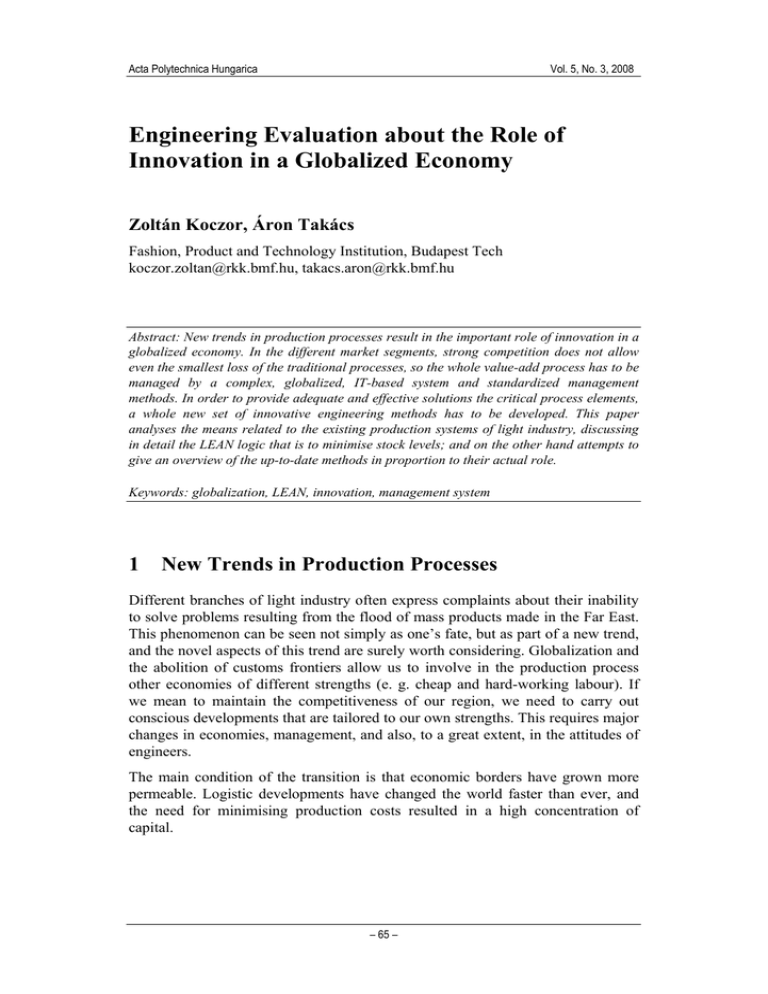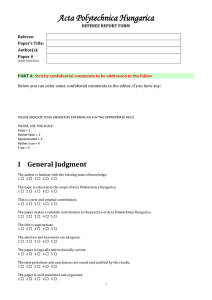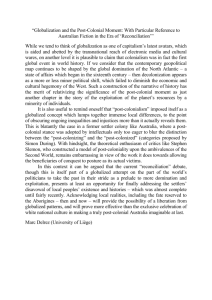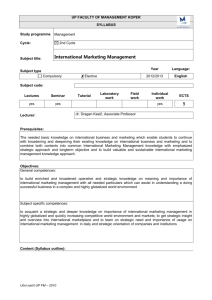Engineering Evaluation about the Role of Innovation in a Globalized Economy
advertisement

Acta Polytechnica Hungarica Vol. 5, No. 3, 2008 Engineering Evaluation about the Role of Innovation in a Globalized Economy Zoltán Koczor, Áron Takács Fashion, Product and Technology Institution, Budapest Tech koczor.zoltan@rkk.bmf.hu, takacs.aron@rkk.bmf.hu Abstract: New trends in production processes result in the important role of innovation in a globalized economy. In the different market segments, strong competition does not allow even the smallest loss of the traditional processes, so the whole value-add process has to be managed by a complex, globalized, IT-based system and standardized management methods. In order to provide adequate and effective solutions the critical process elements, a whole new set of innovative engineering methods has to be developed. This paper analyses the means related to the existing production systems of light industry, discussing in detail the LEAN logic that is to minimise stock levels; and on the other hand attempts to give an overview of the up-to-date methods in proportion to their actual role. Keywords: globalization, LEAN, innovation, management system 1 New Trends in Production Processes Different branches of light industry often express complaints about their inability to solve problems resulting from the flood of mass products made in the Far East. This phenomenon can be seen not simply as one’s fate, but as part of a new trend, and the novel aspects of this trend are surely worth considering. Globalization and the abolition of customs frontiers allow us to involve in the production process other economies of different strengths (e. g. cheap and hard-working labour). If we mean to maintain the competitiveness of our region, we need to carry out conscious developments that are tailored to our own strengths. This requires major changes in economies, management, and also, to a great extent, in the attitudes of engineers. The main condition of the transition is that economic borders have grown more permeable. Logistic developments have changed the world faster than ever, and the need for minimising production costs resulted in a high concentration of capital. – 65 – Z. Koczor et al. Engineering Evaluation about the Role of Innovation in a Globalized Economy Container loaded carrier ships and endless rows of trucks out on the roads are everyday proof that products are worth transiting for thousands of kilometres if the production process is well-designed and plenty of extra value is accumulated at the starting point. We also have the chance to build our strengths in the value-add processes. Strategy for production organization in the 1930’s T-Model Steel industry suppliers Mining … Timber Industry suppliers Forests 1930… Supplier safety Static hierarchy High transaction costs Rubber industry suppliers … … Strategy for production organization in 2000 serial production Transaction points • • • • • • • • Standard criteria Compatibility costs Minimal process costs Globalizing problem solving culture Capital efficiency Capacity efficiency Improving quality parameters Flexibility Figure 1 Production strategy adapted to the new conditions and aims in car industry Besides the changes affecting the market strategy, the economy and the management, skills to be developed by engineering must also be considered. This includes minimising stock levels, reducing production changeovers time, developing flexible production systems, and reducing costs and time loss. Just In Time assembled product Minimal stocks Extending the system for producers and suppliers High level of communication Approval system Change management FIFO Programming, project planning Briding the actual geographical distances Figure 2 Production strategy adapted to the new conditions and aims – 66 – Capability for tolerance/ conformity Acta Polytechnica Hungarica Vol. 5, No. 3, 2008 The demands from the development of the production system in the globalized economy include: marketable products; a wide range of products as a result of seller’s market; order based production (or stock levels close to the order level) and the least costs. There are a growing number of methods to reach these aims: conscious and innovative management of product design [1]; network of suppliers (quality partners) through the necessary IT means; supporting quick processes and changeovers through flexible production equipment; general use of approval and logistics methods (e. g. Production Part Approval Process, Just in Time). 2 Value Loss in the Processes An essential characteristic of the evolution of production and service processes is that different activities and operations are arranged in a hierarchical system. To implement this, the activity conditions are created according to the optimal capital concentration. The targets of innovation were different technological and service steps at first, and harmonized processes later. These processes constitute the elements of the supplier chain, which usually constituted separate interests from the point of view of ownership and investment. The whole production/service cycle has to be constantly improved and optimised according to the investors’ interests and owners’ objectives (which is usually maximum long-term profit). This requires the reasonable and manageable modification of the economic, organizational and engineering means, for which methodological standards are commonly used (e. g. ISO 9001, SixSigma, TQM) on the basis of the best practice. 3 Commonly Used Methods of Value and Resource Analysis for the Whole Production Process. Value Stream Mapping (VSM) The previous model, which seems to be ideal at first sight, reveals losses when analysed from the perspective of the whole production/service cycle. Optimising the supplier chain according to several particular interests is not optimal from the viewpoint of marketability and customer retention. Bridging particular interests was necessary where liberal market rules transform this into value. The implementation is only possible if activities can be supported by apt management and relevant information. Of course, at the end of the high-level innovation, the best practice will necessarily turn to standards (pull-production, LEAN). – 67 – Z. Koczor et al. Engineering Evaluation about the Role of Innovation in a Globalized Economy While solving the problem, a demand emerges for a system that meets global requirements from the side of the full product/service cycle, and at the same time, is not in conflict with the elements of the production/service chain. This can logically start from the distributor’s side. Coordination and approval of the activity chain is needed, parallel with constant communication. The most important supportive standard is the latest version of the ISO TS 16949 standard, which is constantly improved based on the best practice. This method is supported not only by standard regulations, but also by independent auditors, and the supervisory and problem-solving methods developed by the customers (process auditing methods, experimental design, risk analyses: FMEA, reaction standards, 8D, error elimination methods: SPC, Poka-Yoke, etc). Non-value valueNon add time alue-add Value time E1 E2 E3 E4 E5 Vi Week 1 - Value-add Week 2 Week 3 - Business NVA Week 4 - All other NVA Figure 3 Non-value valueNon add time alue-add Value time Time map for conventional production/service processes Ei … Vi … Week 1 - Value-add Week 2 Week 3 - Business NVA Week 4 - All other NVA Figure 4 Time map for production/service processes after innovation Reducing lead times requires conscious decisions, and sometimes the reorganization of production capacities is also inevitable. The main points and the evaluation of successfulness are defined by economic aspects, which also assign – 68 – Acta Polytechnica Hungarica Vol. 5, No. 3, 2008 engineering activities. There is a need today for the innovation of value-add processes, which also involves, besides general improvement, building in one’s own strengths. Out of the demanded innovations (demand pull [3]), some problems have major importance: − developing balanced production/service production programs to support activities that are homogeneous and inhomogeneous in time − optimising production changeovers and the time demand of production (methodology, optimising parameters) − value-oriented minimisation of process times (Value Stream Mapping [4], JIT) − harmonizing the maintenance system with the minimal costs of the valueadd process (TPM) − minimising deviation, a high level of achieving the objectives (SixSigma) Throughout the whole value-add process, losses resulting from capital commitment can be eliminated by the adaptation of conventional activities on the basis of a new approach. In the value-oriented analysis, activities related to changeovers, maintenance and process starting are necessary, however, they are not actually profitable from the point of view of the product (business processes). For these activities the main aim is to reduce time cycle and to implement the relating functions at the highest possible level. PCE = E(1 − ∑ Ki ) N N j=1 i=1 E + ( ∑ Lj + ∑ ni ⋅Si + T ) − PCE – process efficiency − E – value-add time in the process − Ki – losses related to process quality and the decrease of efficiency resulting from future waste recycling − Li – losses resulting from setting the operations, changeovers and maintenance − Si – average loss time of units queued up between the operations − ni – the amount of units queued up between the operations − N – number of operations − T – average loss time of raw material and products in the storage – 69 – Z. Koczor et al. Engineering Evaluation about the Role of Innovation in a Globalized Economy The phases of innovation related to the process are: PROFIT PERFECTION The “lean way”: continuous perfection of the processes through the elimination of losses Production adapted to customer demands PULL FLOW Continuous maintenance of flow (material, information) VALUE STREAM Connecting value-added steps into a process VALUE Defining value-added steps of the process Figure 5 Innovation phases (starting from below) Process phases that do not add value – for example, waiting, “must” processes and wastes – cause considerable increase in the costs, together with financial and commercial value losses. If these losses can be eliminated by organizational, process-planning and controlling methods, then we can remain competitive despite the relatively high salaries and their costs characteristic of this branch of industry. Table 1 Phases of change management Planned means of changes Aim, direction Task, function Method, standard Result Analysis Analysing organizational culture and the ability to change Process structure, procurement strategy, losses, analysis of the inner/outer environment Process definition (VSM), analysis, collecting inner experience Process and organization analysis Decision Defining the modified process, the organization, establishing consensus Target values, time plan, defining interests Workshops, project definition, communication Vision for the future, team, consensus, management support Introduction, activity Subtle design and implementation of the change Planning, allocating resources, timing, coordination DOE, GANTT, project follow-up, risk evaluation Plan, risk analysis, expectable assets, consensus Feedback Systemising the results of the innovation Managing change, risks and expectable assets Documentation, team work, workshops, communication Modified process, better performance, changed organizational culture – 70 – Acta Polytechnica Hungarica Vol. 5, No. 3, 2008 In practice, the projects aiming to achieve these objectives were implemented on the basis of a multiphase methodological system. The main scheme of that follows standards that support the implementation of radical changes (change management [2], BPR). During the practical implementation, we used this methodology in several research projects. The novel approach has revealed an amazing amount of reserves. We have found that the efficiency of processes can considerably be increased (sometimes even by a few hundred per cent) not only in case of the traditional textile, leather and clothing industry, and the electronically assembling and production – which perfectly fits the traditional model of light industry –, but also in case of the economic and service processes, for example invoicing, administration and customer support. 4 Extending the Method; the Ideal Level of Total Social Costs It is a common source of annoyance when a business activity is purely controlled by the interests of those directly involved, without taking into consideration the fact that many other participants also pronounce their demands. If we take the case of communal infrastructure maintenance works, for example, both the interests of the local authority for cost reduction and strict deadlines and the interest of the entrepreneur for maximal profit can be detected. The social consequences of the risks of pedestrians, the fuel costs of queued up cars and the extra adrenaline of both groups are aspects lying outside the business agreement. Highly organized economy support systems are capable of modelling the complexity of social values. This include environmental protection regulations (e. g. fines); legal possibilities with a social perspective (e. g. permission processes), and the like. There is a trend in globalized processes that the optimisation is more complex: its modelling area does not simply involve the operations, but it is extended to the technological steps and processes, process systems and the design method applied to the different elements of the production chain. If the trend continues, our present knowledge can be integrated from the perspective of product life cycle and product dynamics. At the same, it is also useful to extend the process from the point of view of social interests, with those components that have relevance in the success of the business. If we adapt this trend voluntarily to our business processes, it can bare practical economic advantages. – 71 – Z. Koczor et al. Engineering Evaluation about the Role of Innovation in a Globalized Economy („You should not be afraid of the complex, but the confused” [5].) The condition for success is that we should see everyone involved, together with the external effects, as weighted risk factors in the (long-term) innovation process. The basis of the new approach is that previously not involved interests have to be represented. During that we must translate into numbers how much realisable and intensive the interests are, as well as the characteristics of the processes that are expected to influence our case. The direction of the innovation allows that the adapted processes can have advantages in the given context. We initiated a research on the field of light industry to interpret the extra demands related to the production processes. The demanded “giant leaps” in developing the structure of the full implementation cycle can only be realized by taking into consideration the above mentioned aspects. The important extra demands in light industry processes, which used to be interpreted in an instinctive way are: − realizing the aspects of environmental protection in process definition, − fashion making, and the issue of fashion dynamics, − managing the effects of work conditions, and the degree of the involvement of key workers, − planning for the special demands of usage [6, 7], − process planning segmented from the point of view of capital processes. The practical steps of the innovation process will be separated if they are to be adapted to the modification of an existing value-add process; or, in other cases, a new set of processes has to be developed. In case of light industry, the realization of the above mentioned objectives should not be expected solely from the individual market agents. Conscious innovation of such processes represents the interests of the whole national economy in a globalized world market. Major supporters of this practice in a globalized context are the benchmarking based evaluations and process innovations implemented in European Framework Programmes, in which Hungary is also involved [8]. Conclusion Losses of the whole production/service cycle require organisational and technical analyses. This paper recommends methodologies, which are standardised, and provides optimisation of facilities according to determined aims. References [1] Némethné, dr. Erdődi Katalin: Risk Management and Loss Optimization at Design Process of Products BMF RKK 2007, Bp. – 72 – Acta Polytechnica Hungarica Vol. 5, No. 3, 2008 [2] Russel-Jones, Neil: Változásmenedzsment, Manager Könyvkiadó Kft. 2005, pp. 72-73 [3] Béla Pataki: Technológiaváltások menedzselése MK-MMT 1999 [4] The Lean Six Sigma Pocket Tool book, GE 2003 [5] Péter Esterházy: A szavak csodálatos életéből www.mindentudas.hu/mindentudasegyeteme/20030904esterhazy [6] Vera Göndör, Márta Pataki: Designing Textile Products for the Full Life Cycle with a Special Focus on Maintenance during Usage, BMF RKK 2007, Bp. [7] Tibor Gregász, Endre Korondi: Influence of Maintenance Strategies on Environmental Load, BMF RKK 2007, Bp. [8] ETIS-CT-2004-508564-RPOJECT ITE is funded by the European Commission – 73 –







